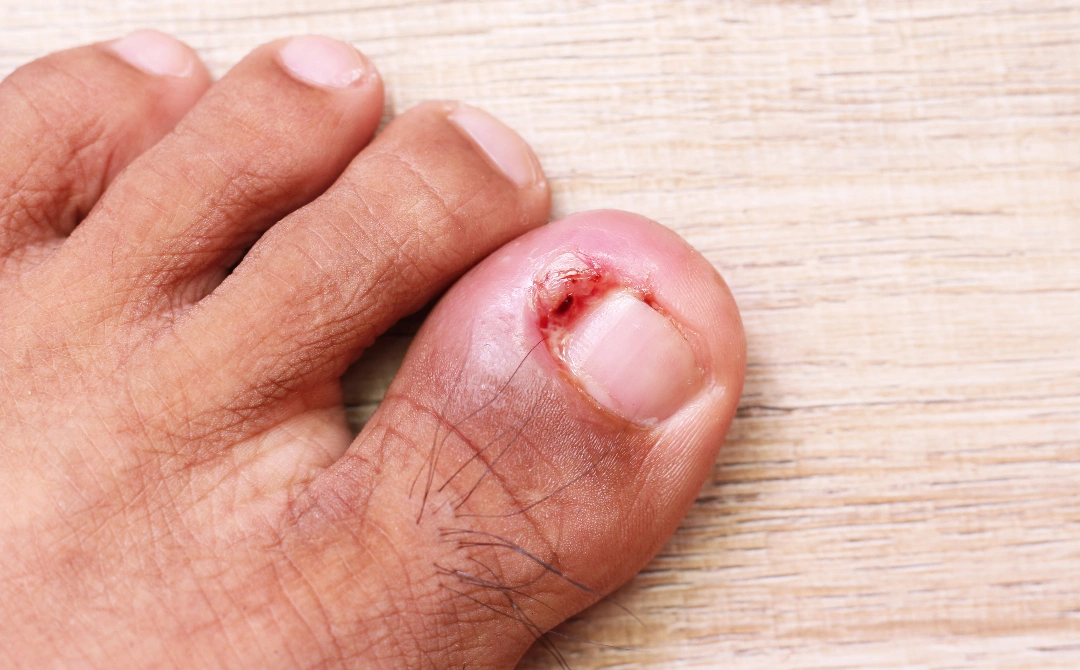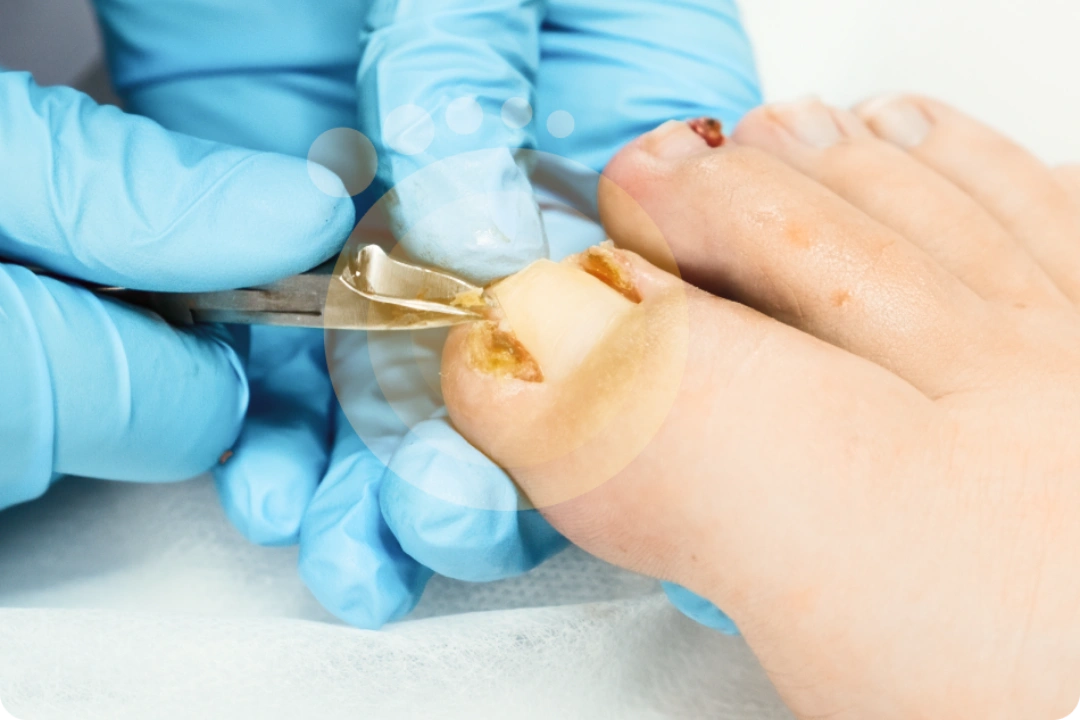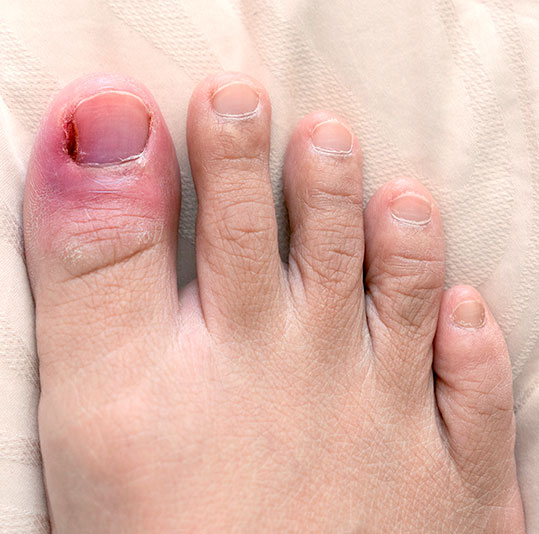Ingrown toenails are a common and often painful condition that occurs when the edge of the toenail grows into the surrounding skin. The pressure and irritation can lead to redness, swelling, and, in more severe cases, infection. While some mild cases may improve with simple foot care, recurring or inflamed ingrown toenails often need professional attention to prevent further discomfort and tissue damage.
Modern podiatric treatments can relieve pain effectively, correct the nail’s growth pattern and lower the risk of recurrence. With proper care and timely intervention, most people recover quickly and can return to their usual activities without long-term complications.
When do you need treatment for an ingrown toenail?
In some cases, an ingrown toenail may improve with simple self-care. However, certain signs suggest that professional treatment is needed to prevent infection or ongoing pain. Recognising these warning symptoms early helps ensure proper healing and reduces the risk of recurrence.
You should seek medical attention if you notice:
- Persistent pain, redness or swelling around the nail edge
- Pus, discharge or warmth suggesting infection
- Overgrown or thickened skin beside the nail
- Difficulty walking or wearing shoes comfortably
- Repeated ingrown toenails that keep returning
Extra care is especially important for:
- People with diabetes or poor circulation
- Older adults with thickened or hard-to-trim nails
- Those with nerve damage or reduced sensation in the feet
Prompt podiatric care not only relieves pain but also prevents complications and supports healthy nail regrowth.

How is an ingrown toenail treated at Atlas Podiatry?
Treatment for an ingrown toenail depends on how deeply the nail has grown into the skin and whether infection is present. Early cases may respond well to conservative care, while more advanced or recurring cases may need a minor procedure to restore comfort and prevent regrowth.
Conservative Management (Early-Stage Ingrown Toenails)
For mild or early-stage ingrown toenails, conservative care helps relieve discomfort and guide proper nail growth without surgery.
- Nail edge lifting, cleaning and antiseptic dressing — gently elevates the nail edge from the skin to reduce pressure and inflammation.
- Slant back cut — the podiatrist trims the nail corner at an angle to relieve pain and allow the nail to grow out correctly.
- Monitoring of nail growth — regular reviews ensure the nail continues to grow in the right direction and does not recur.
- Footwear and nail care advice — guidance on shoe selection, hygiene and trimming habits to prevent future ingrown nails.
Onyfix Nail Bracing (Pain-Free Correction)
Onyfix is a non-surgical, pain-free bracing system applied directly to the nail surface. The custom adhesive brace gently guides the nail back to its natural shape as it grows, without injections or anaesthesia. It is especially suitable for needle-averse patients and early to moderate ingrown toenails. This method restores proper nail curvature and helps prevent future recurrence.
Partial Nail Avulsion (Minor Nail Surgery)
For moderate to severe cases involving infection, inflammation or repeated recurrence, a partial nail avulsion may be recommended. The procedure is performed under local anaesthetic to remove only the ingrown section of the nail while preserving the healthy portion. This provides immediate relief from pain and pressure with minimal downtime.
Matrix Cautery (Preventing Regrowth Where Indicated)
In chronic or recurrent cases, matrix cautery may be performed after partial avulsion. A mild chemical agent is applied to the exposed nail matrix, the root area responsible for growth, to permanently stop regrowth of the problematic nail edge. This technique helps prevent future ingrown nails while maintaining the appearance and function of the remaining nail.
Total Nail Avulsion (For Severe or Deformed Nails)
When the entire nail is severely deformed, infected or thickened beyond repair, a total nail avulsion may be required. The procedure involves removing the whole nail under local anaesthetic to allow healthy regrowth from a clean base. It is reserved for advanced cases or those unresponsive to previous treatments.

What to expect after ingrown toenail treatment?
After undergoing treatment for an ingrown toenail, mild tenderness or swelling around the toe is common for the first few days. Proper aftercare supports healing and helps prevent recurrence.
Post-treatment care includes:
- Keeping the toe clean, dry and covered with a light dressing as advised
- Avoiding tight or enclosed shoes until the area has healed completely
- Following any instructions on cleaning the toe at home
- Attending follow-up appointments to ensure healthy nail regrowth and check for any signs of infection
With proper care, most patients experience a quick recovery and lasting relief from pain and discomfort.
What are the benefits of professional ingrown toenail treatment?
Professional care for ingrown toenails ensures that both the cause and symptoms are addressed safely and effectively. Seeking early podiatric treatment provides lasting relief and prevents the problem from recurring.
Key benefits include:
- Immediate reduction in pain and pressure around the affected toe
- Lower risk of infection or tissue overgrowth
- Safe and sterile treatment environment for optimal healing
- Restoration of normal nail growth and natural appearance
- Personalised approach; non-surgical or surgical methods selected according to each patient’s needs
How to prevent future ingrown toenails?
Simple foot care habits can help prevent ingrown toenails from returning and keep your feet healthy in the long run. Consistency in nail and footwear care makes a significant difference in maintaining proper nail growth.
To lower your risk of recurrence:
- Trim your toenails straight across rather than rounding the edges.
- Avoid tight, narrow shoes or high heels that press against the toes.
- Keep your feet clean and dry, and change socks daily to reduce moisture.
- Treat any fungal infections or thickened nails early to prevent nail deformity.
- Schedule regular podiatry visits if you are prone to recurring ingrown nails or have underlying conditions like diabetes.
These simple steps help maintain proper nail alignment, reduce irritation and support overall foot comfort.
Summary
Ingrown toenail treatment focuses on relieving pain, preventing infection and restoring healthy nail growth through safe and effective care. Depending on the severity, treatment may involve conservative nail reshaping, Onyfix nail bracing for gentle correction or minor procedures such as partial nail avulsion and matrix cautery for recurring cases. Each approach aims to ease discomfort and prevent future regrowth of the problematic edge. With proper aftercare, most patients recover and return to normal activities quickly.
If you are experiencing persistent pain, swelling or signs of infection from an ingrown toenail, schedule a consultation with Atlas Podiatry for professional assessment and tailored treatment to restore comfort and keep your feet healthy.
